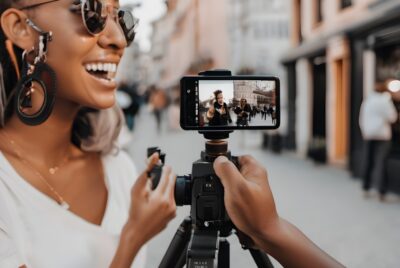Smartphone Photography
Smartphone Photography: Unlocking Your Device’s Full Potential
With advancements in smartphone technology, capturing beautiful, professional-quality photos has never been easier.
Gone are the days when only dedicated cameras could produce remarkable shots. Today, nearly everyone has access to a powerful camera right in their pocket. If you’re looking to elevate your smartphone photography game, this guide is for you. We’ll cover the essentials, from camera settings to composition techniques, so you can start taking stunning photos with confidence.
Why Smartphone Photography?
Smartphones have become a popular choice for photography enthusiasts and casual photographers alike. Some professional photographers are now only using their smartphones for their work. Here’s why they’re so compelling.
The Convenience Factor
Unlike traditional cameras, smartphones are lightweight and fit right in your pocket. Whether you’re traveling, attending an event, or simply exploring, having a reliable camera on hand at all times makes capturing life’s spontaneous moments easy and effortless.
Smartphone Cameras Have Come a Long Way
With advancements in sensor technology, smartphones now boast multiple lenses, high-resolution sensors, and powerful image-processing software. This combination makes them incredibly versatile, enabling users to capture crisp details, vibrant colors, and even remarkable low-light shots.
Mastering Your Smartphone Camera Settings
To maximize the potential of your smartphone’s camera, familiarize yourself with its key settings. Understanding these can make a significant difference in the quality of your photos.
Understanding Key Settings
The default settings might not always work best for every situation. Here’s a look at some essential settings you should know.
Resolution and Aspect Ratio
Adjusting the resolution allows you to control the level of detail in your images. For high-quality photos, choose the highest resolution available. Aspect ratio options, like 16:9 or 4:3, change the shape of your photo, impacting its composition.
Exposure and ISO
Exposure and ISO settings manage the brightness of your image. Higher ISO settings help in low-light situations, but they can introduce noise. Learning to balance these settings is key to capturing clear, well-lit photos in different environments.
Shutter Speed
Shutter speed controls how long the sensor is exposed to light. Faster shutter speeds freeze motion, making them ideal for action shots, while slower speeds allow more light in, perfect for low-light scenarios or creating motion blur effects.
The Importance of Lighting in Smartphone Photography
Light is one of the most critical elements in photography. Knowing how to use both natural and artificial lighting can elevate your smartphone photos significantly.
Utilizing Natural Light
Natural light is often the most flattering and versatile for smartphone photography. Early morning and late afternoon provide a warm, soft light ideal for portraits and landscapes. Experiment with side or backlighting to add depth and drama to your shots.
Experimenting with Artificial Light
Smartphone cameras often struggle in low light, but adding artificial light can help. Use LED lights or a small, portable lamp to brighten up your subject, and play with angles to achieve different effects without harsh shadows.

Composition Techniques for Stunning Smartphone Shots
Good composition transforms an average photo into an extraordinary one. Master these techniques to create visually engaging images. Use the camera settings menu in your smartphone to help achieve the right composition.
Rule of Thirds
The rule of thirds divides the frame into a 3×3 grid, helping you position your subject off-center for a more balanced and dynamic composition. Most smartphones allow you to display this grid, making it easy to apply. Learn more photography basics.
Level
Most cameras have a level indicator to show when the camera is completely horizontal. This can be switched on in camera settings menu to help ensure horizons and other features are horizontal or level.
Leading Lines and Framing
Leading lines, like paths or roads, guide the viewer’s eye toward the subject, while natural frames, like archways or windows, create depth and direct focus. These techniques add a sense of journey and intrigue to your photos.
Capturing Portraits with Smartphones
Portrait photography on smartphones has become incredibly popular. Here’s how to make the most of your device’s portrait capabilities.
Utilizing Portrait Mode
Portrait mode adds a beautiful bokeh effect, blurring the background and making the subject stand out. Experiment with this feature to create professional-looking portraits.
Tips for Natural and Authentic Portraits
Engage with your subject to capture genuine expressions. Encourage movement or have them look away from the camera for a more candid, relaxed feel. Pay attention to background elements, as they can add context and complement the portrait.
> > > See the full range and prices of smartphones CLICK HERE < < <
Editing Your Smartphone Photos Like a Pro
Editing can bring out the best in your photos. Here are some tips and tools to help you polish your images effectively.
Recommended Editing Apps
Apps like Snapseed, VSCO, and Lightroom Mobile offer powerful tools for enhancing smartphone photos. They’re user-friendly and provide many options to fine-tune your images.
Basic Editing Techniques
Start by adjusting brightness, contrast, and saturation. These simple tweaks can make colors pop and details stand out, giving your photos a polished look.
Adding a Personal Touch with Filters
Filters can transform the mood of your photo. Whether you want a vintage vibe or a high-contrast look, apply filters sparingly to keep your edits looking natural.
Must have Smartphone Accessories
I recommend two must have accessories if you want to produce pro quality photos on your smart phone. The first is a protective case with a built in battery pack which will give you much more power at your fingertips for a long photo session. The second is a selfie stick with built in tripod and remote control. This can be used to support your camera for long exposure shots, for holding your camera upside down for reflection shots and allowing you to be in the photo using the remote control. You can find these HERE for battery case and HERE for selfie stick tripod.

Conclusion:
Embrace the Art of Smartphone Photography Smartphone photography is an exciting and accessible art form. With a little practice and creativity, you can produce stunning images that rival those taken with professional cameras. Explore your settings, experiment with lighting, and apply editing techniques to discover what works best for your style. Embrace the journey, and keep capturing moments that matter.
> > > See the full range and prices of smartphones CLICK HERE < < <
FAQs
What are the best apps for editing smartphone photos?
Some top-rated apps include Snapseed, Lightroom Mobile, and VSCO, all of which provide advanced editing tools to enhance your photos.
Can I take professional-quality photos with a smartphone?
Absolutely! With proper technique and settings, smartphone cameras are capable of producing high-quality images that can rival those taken on traditional cameras.
How can I improve low-light smartphone photography?
Utilize artificial lighting sources, adjust ISO settings, and consider using night mode to capture clearer images in low-light situations.
Is it worth investing in smartphone photography accessories?
Accessories like clip-on lenses and portable lighting can enhance your photography experience and open up creative possibilities, especially if you’re a photography enthusiast. See recommendations above.
What settings should I start with as a beginner?
Start with exploring exposure, ISO, and focus settings, and use the grid for composition. As you become comfortable, experiment with advanced settings like shutter speed and RAW format.
Further reading
Check out our other relevant articles:
Art of Portrait Photography: Master Techniques for Stunning Shots
For educational resources on smartphone photography, check out these guides:
1. Digital Photography School offers a comprehensive guide with practical tips, such as cleaning your lens, using natural light, and adjusting your smartphone’s brightness manually to improve photo quality. They also cover settings like HDR, which enhances image detail by balancing shadows and highlights. This guide is a great starting point if you’re new to smartphone photography or looking to refine your technique.
2. Photography Concentrate provides an in-depth look at smartphone camera quality, apps, and accessories. They discuss essential photography basics, such as composition, lighting, and depth of field. The guide also highlights smartphone accessories like telephoto lens attachments and portable battery packs, which can elevate your photography game, particularly for on-the-go shooting.
These resources cover foundational skills and advanced tips to help you create professional-quality images using your smartphone. You can find the guides here at Digital Photography School and here at Photography Concentrate.




